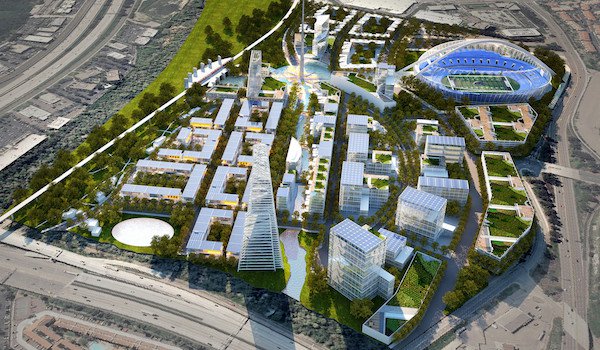Charger Exit from Mission Valley Exposing Power Players vs. Parks and SDSU

Mission Valley is at a crossroads. With the looming exit of the San Diego Chargers and politicians playing hot potato with development plans and initiatives, it’s hard to gauge what will happen with the Qualcomm Stadium site. Here’s what we know.
As soon as the Chargers announced their desires to leave Qualcomm Stadium, citing infrastructure deficiencies, a number of projects have been suggested by a number of different groups.
The first one came from Mayor Faulconer, who wanted the Chargers to stay in Mission Valley and was willing to put $350 million in public funds – in conjunction with the county – toward the construction of a new Qualcomm Stadium.
The plan was the brainchild of CSAG, the stadium advisory group created by the mayor and his team. That group also lobbied the city council, who authorized spending $2.1 million in public funds for an expedited environmental impact report (EIR), which the Chargers called “not legally defensible” in court.
Then came the Citizens’ Plan for Tourism Reform, championed by former City Councilmember Donna Frye and authored by attorney Cory Briggs. The plan’s cornerstone messages are to preserve local resources and protect local taxpayers. The critical components of the plan focus on the future of Mission Valley, calling for higher education expansion and protecting and preserving the San Diego River Park. It’s a bold vision that’s clearly the most popular concept in the public purview, as noted by the San Diego Union-Tribune poll, where 95% of the more than 62,000 people who voted agreed with the vision.
The Chargers initially endorsed the Citizens’ Plan, but since the initiative does not allow for the use of public funds for a stadium, they created their own measure. The Chargers Plan would raise the City of San Diego’s Transient Oriented Taxes or TOT from 12.5% to 16.5% and re-direct most of those tourism dollars to building a new stadium and expanding the convention center away from the waterfront.
The Stadium/Mission Valley ordeal has impacted the city council races in San Diego, as Democrats and Republicans vie for control of the council. This is especially true in Districts 7 and 1 where the political consultants have used the issue as a battleground for messaging and votes.
District 7, which encompasses most of Mission Valley, has Republican incumbent Scott Sherman running against Democrats Justin DeCesare and Jose Caballero.
Sherman was a champion of the mayor’s efforts, the $350 million tax subsidy, to keep the Chargers in Mission Valley, who added his own high-density, condo-centric plan to the equation. His plan also considered a new stadium for the Chargers with a combination of housing, shops, and restaurants:
"A lot of times, people go downtown to the Gaslamp and those types of things,'' Sherman said. "They go there whether or not Petco (Park) has a game going on or not. The same thing could happen here.''
DeCesare, who spent the last two years as chairman of the Tierrasanta Community Planning Group, has stated publicly that he believes the best use of the Qualcomm site would be for park land expansion and protection and higher education opportunities. He has endorsed the Citizens’ Plan, which would provide for such uses.
He has criticized Sherman for not focusing on neighborhood concerns and his plans for Mission Valley.
“The incumbent Councilmember for my district has been promoting an irresponsible plan for a new stadium that would create gridlock in Mission Valley and has already cost taxpayers millions for an environmental report that the Chargers themselves called flawed and indefensible,” he said. “The initiative [Citizens’ Plan for Tourism Reform] offers a more environmentally and fiscally responsible approach."
As contentious as the volleys have been over the future of Mission Valley between Sherman and DeCesare in District 7, in District 1 the election has devolved into an all out war of words.
Bry who touts herself as an entrepreneur, teacher, journalist, and community volunteer has openly endorsed the Citizens’ Plan for San Diego.
“[The Citizens’ Plan for Tourism Reform] offers a vision for re-use of the Qualcomm site for university-related development and creation of a river park and trail that could transform Mission Valley.” Bry said. “ And it would generate at least $18 million per year for the city’s general fund that could be used to begin addressing the city’s huge backlog of neighborhood infrastructure improvements.”
Ellis, who is being funded by the Lincoln Club, which is politically aligned with the mayor, has consistently claimed that the Citizens’ Plan would raise taxes on residents to build a downtown stadium. Ellis, who has sent out mailers branding Bry as a supporter of such a concept, said the following, “Barbara Bry supports what would be one of the largest tax increases in the city’s history."
Voters will get to decide on June 7 which message is resonating and which candidate has a better vision for San Diego. As for the initiatives, the Chargers Initiative still has to qualify for the November ballot, while the Citizens’ Plan for Tourism Reform has all but assured its place on the ballot after turning in 100,845 signatures to the registrar.





